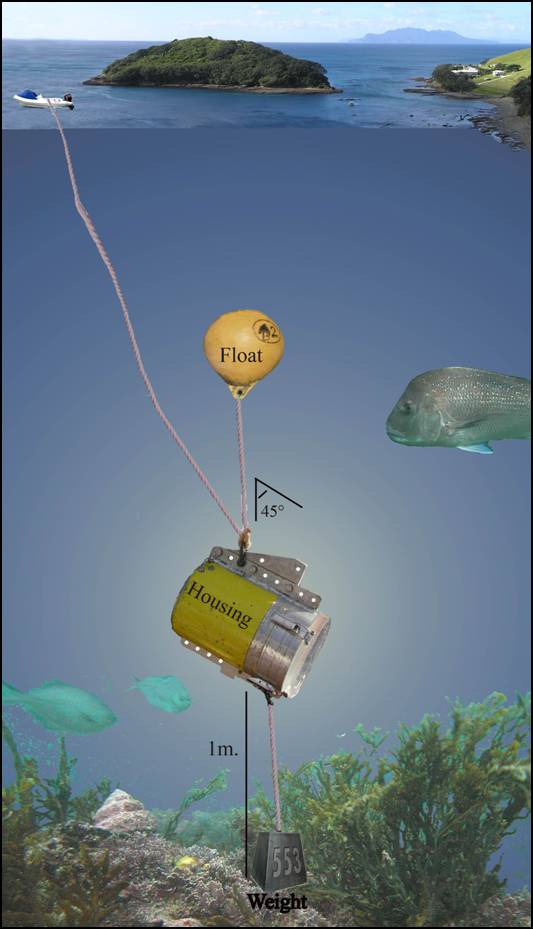 A simple homemade drop video camera systemTo anyone first considering creating a marine reserve, the task of deciding what information is required and how you will obtain it is a daunting one. There are two hurdles to understand. Once understood, you can plot your course through them:
A simple homemade drop video camera systemTo anyone first considering creating a marine reserve, the task of deciding what information is required and how you will obtain it is a daunting one. There are two hurdles to understand. Once understood, you can plot your course through them:
➢ The ocean is vast, dynamic with huge natural variations, largely unstudied, and often a difficult place logistically to study and gather information about. We can't know everything about it, and that's OK as we don't need to know everything in order to act on marine conservation.
➢ The legislative requirements in some cases are clear and specific, but in most cases are vague and in the end must be quite subjectively interpreted by DoC and ultimately the Ministers of Transport, Fisheries and Conservation.
We suggest that you plan your information gathering process by first looking at the end of the process to get as clear as possible picture of what you will strive to assemble. The information gathering process suggested here is modeled on arriving at all you need to succeed with a marine reserve application, however a great deal of it would be very useful to support, design and promote a proposal in the context of a marine protection forum.
Sources of Guidance
Start with the Marine Reserves Act 1971 and be familiar with the criteria required. All other advice, from the Department of Conservation or others, is based on someone's interpretation of the Act, so this is where you should start. You should have a copy of the Act close to hand throughout your campaign.
➢ The Legislation in a Nutshell – is a summary paper also worthwhile to study, it presents an overview of our interpretation of the Marine Reserve Act.
The information gathering process cannot be separated from the consultation process. Look through the various consultation related sections of the How to Kit before forming a plan for this stage of your campaign.
Before you get too far with background reading and planning we highly recommend that you read Bill Ballantine's 1991 book Marine Reserves for New Zealand. In our opinion, it remains the single most valuable resource on all aspects of understanding and creating marine reserves. Numerous excerpts from the book are used throughout this Kit, however the link above takes you to the full and complete version, which Bill helped us to produce in electronic form for this Kit. A hint: go back to the book every now and then for review, it is an excellent resource for quick review and inspiration.
 Past natural abundance gives us a clue a what a marine reserve could be likeFor guidance, examples and advice on designing your marine reserve and situating it within a marine reserve network, see the Reserve Design folder in the Library section of this How to Kit.
Past natural abundance gives us a clue a what a marine reserve could be likeFor guidance, examples and advice on designing your marine reserve and situating it within a marine reserve network, see the Reserve Design folder in the Library section of this How to Kit.
It is helpful to read several past marine reserve applications, discussion documents and draft proposals to see what they did. In this resource we have many of these documents from past marine reserve campaigns. They can be found in the Case Study section and in the Library you will see a list of the documents which you can download in the marine reserve applications and proposals folder. It is suggested that you have a brief read through of all the advice pages in the Formal Application section of this Kit, for information and examples on the kind of information and level of detail required for a successful formal application document.
Study the DoC 2002 Handbook for Prospective Applicants (Working Draft) very carefully. Make notes on how the recommendations and strategies provided relate to your situation, the area of interest on your coast and your community. Be very specific in planning how the information you seek can be obtained and who can help you do this.
Have a look at the Marine Reserves Protocol document established between the Department of Conservation and the Ministry of Fisheries. It provides an important guideline to what is actually expected in terms of information.
Note: You may get highly divergent advice on some of the information requirements, so in the end your group will have to make these decisions. When making these decisions go back to the Marine Reserves Act and ask yourself is your interpretation here consistent with what is actually written in the Act and can you defend this interpretation to others.
Once familiar with information requirements, it is a good idea to develop an information gathering plan. In the areas of biological survey and legal information, it is essential to have some form of professional assistance from a practicing marine biologist or ecologist.
DoC and local government officials should be helpful. Often, local universities, polytechnics or secondary schools will have a staff member or senior student may assist. In some communities there will be self-trained naturalists or people with extensive local knowledge that can be of assistance.
Getting Going
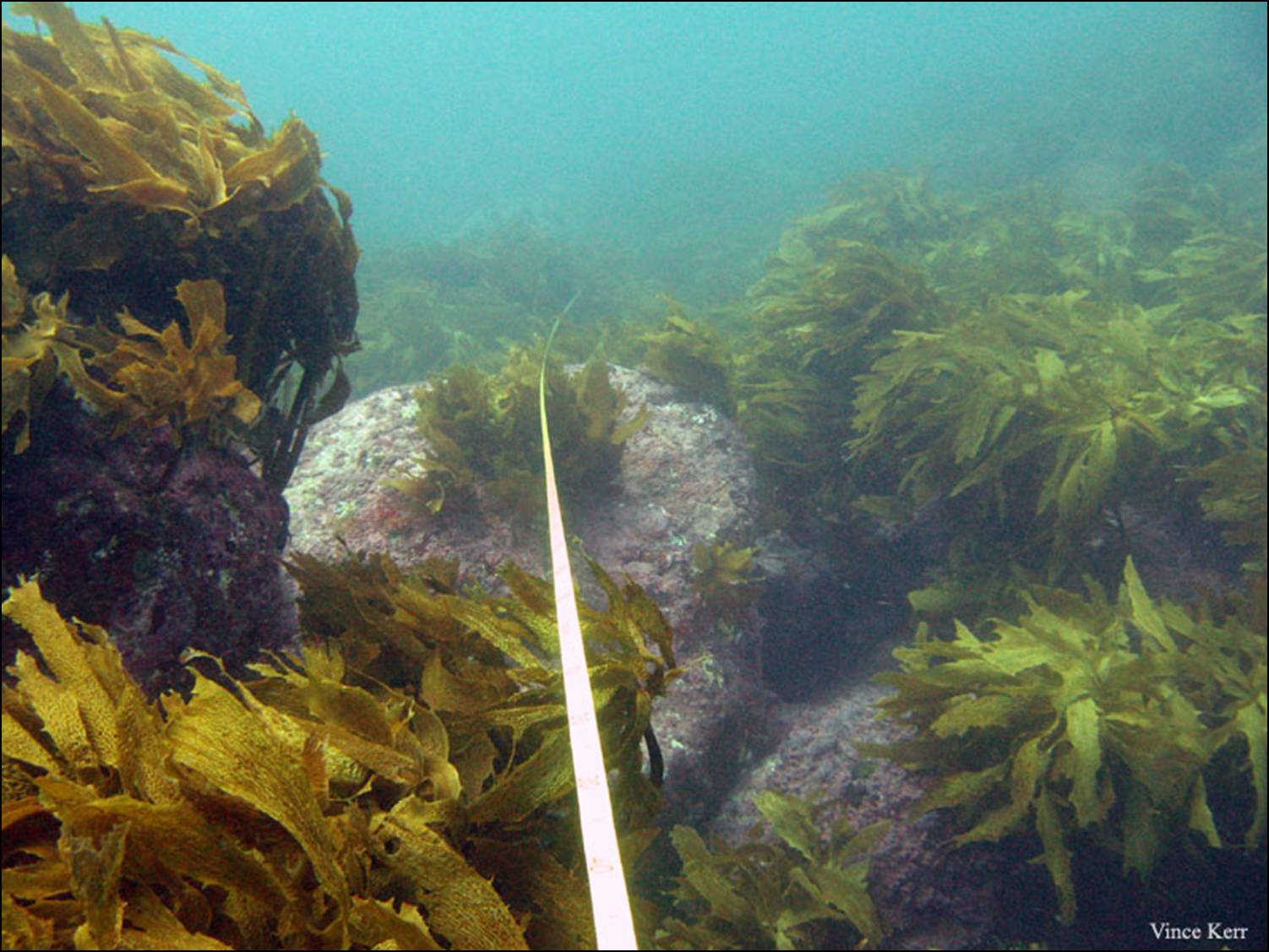 Consider teaming up with local divers and get out there and survey your local reefHere is checklist to prompt you for making your information gathering plan.
Consider teaming up with local divers and get out there and survey your local reefHere is checklist to prompt you for making your information gathering plan.
➢ Scientific & Biodiversity Information
Maps/charts
Aerial photos
Biological surveys
Habitat maps
Underwater photos, clubs, enthusiasts
GIS information held by Government departments
Fishermen
Scientific journals, reports
Newspaper archives
Testimonials of long-time residents
Iwi historical studies or Waitangi Tribunal claims
MinFish information
General fisheries information
➢ Users of Resource or Area of interest
Visitor Use Surveys
➢ Public interest, support for the proposed Marine Reserve
Generic published work
Surveys of your area and community
Public meetings
➢ Parties Affected and Parties requiring statutory notification
Council information
Cadastral maps
Terraview maps
Title searches
➢ Legal status of area of interest
Legal designation
Issued consents, etc.
Seek council and DoC support
Consultation
From the beginning you need to build a list of people and groups in your community that have an interest in the marine environment you are wanting to work with. The best scenario is if you invite and include representatives of these groups within your working group. Often the best strategy is to go to them initially and say what you wanting to do and ask for their help and involvement. This approach is a good way to begin a relationship with local iwi or hapu if you don't already have one. If not known already, introduce yourself to your local hapu and ask for their guidance and involvement as you begin to work on your project. The ideal situation is where the project is developed and carried out as partnership between a community group and the local hapu. This may save you from negative responses later on in the process. One example of a partnership with a local hapu leading to a marine reserve proposal is the Mimiwhangata Marine Reserve Proposal which arose from a partnership between DoC and a coastal hapu Te Uri O Hikihiki. See also the Mimiwhangata folder in the Case Studies section.
The all important area of consultation is visited in many places in this resource as it is connected and important to virtually every stage of the process. It is a good idea to carefully record and archive the consultation work that you do. How you use this record in later parts of the process will be further explained as we go.
Site Survey and Investigation
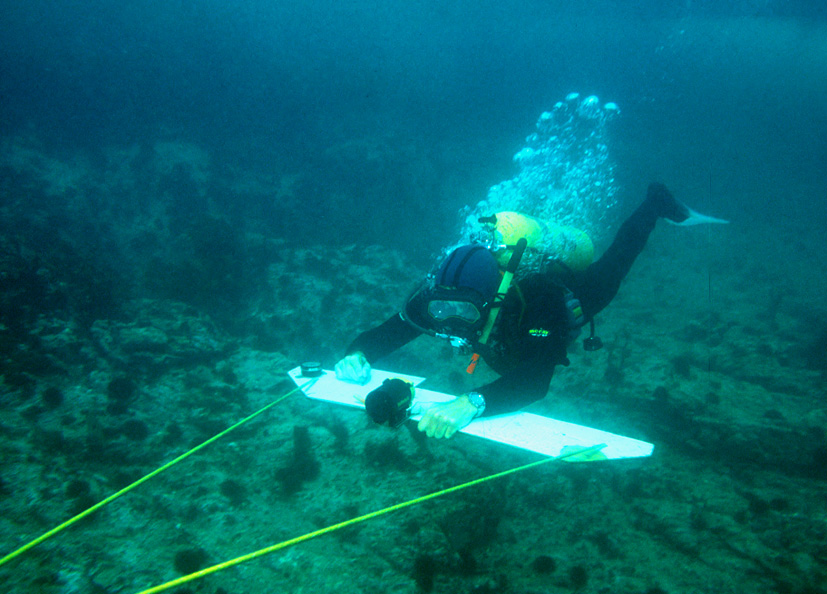 The manta board, a surprisingly useful survey tool and fun.....Site investigations are generally considered to be required for the approval of a marine reserve proposal. As mentioned in the Introduction page of this section, it is advisable to enlist professional assistance in planning or at least the supervision of this work. Site survey work that does not have professional supervision may be questioned at a later stage of the process. It is perfectly appropriate to request assistance from the Department of Conservation in this area. Also, it is a good idea to involve a MPI contact person in the planning stage of any site investigation.
The manta board, a surprisingly useful survey tool and fun.....Site investigations are generally considered to be required for the approval of a marine reserve proposal. As mentioned in the Introduction page of this section, it is advisable to enlist professional assistance in planning or at least the supervision of this work. Site survey work that does not have professional supervision may be questioned at a later stage of the process. It is perfectly appropriate to request assistance from the Department of Conservation in this area. Also, it is a good idea to involve a MPI contact person in the planning stage of any site investigation.
➢ For information, examples and advice on designing a marine reserve and situating it within a network, see the Reserve Design folder.
Here is some Department of Conservation advice from the Handbook for Applicants:
When embarking upon investigations, consider the following four points:
(1) Does the site meet the requirements of the Marine Reserves Act 1971? Interpretation if this part of the Act is about how your site is special or unique in terms of habitats, geology and species or is typical of marine habitats of the area. What this means is that part of the this requirement is to describe the species and habitats of the proposal area.
(2) Does the site have the support of a majority of the community?
(3) Have you considered all possible impacts on other users of the area?
(4) Do you have sufficient information about the site to warrant making an application to the Director-General of Conservation?
We suggest that you become familiar with the references indicated below to guide your planning. Don't be daunted by the task, it is actually great fun to do this work and there are many ways to recruit assistance. A classic example of an inventive approach is the survey of Mokohinau Islands in the Outer Hauraki Gulf that Bill Ballantine and Leigh Marine Laboratory organized by enlisting the military to provide dive teams and helicopters!
Below we list important resources which can support developing marine studies of your area. As you work through the past marine reserve proposal and application DoCuments you will gain more understanding of the what useful information to gather for your project.
Site Survey References
1. DoC's marine biodiversity monitoring and research tool box. This is the entry page on the DoC web site that takes you to a series of specific how to pages which explain various survey and monitoring. This is an excellent resource and has been developed from actual work done in marine reserves to date. It's strength is in general background information on survey tecnhniques and standardisation of technics for a range of species considered important in the coastal envrionment.
2. "Studying Temperate Marine Environments – A Handbook for Ecologists", edited by Michael Kingsford and Chris Battershill (1998). (Can be purchased from your local bookseller or obtained from your local library). This is an excellent technical manual used by biologist widely. Requires some background in marine biology and field work.
3. Marine Reserves Protocol, Department of Conservation and Ministry of Fisheries, 2003.
4. DoC Handbook for Applicants: Site Survey and Investigation
5. Chapter 13 Marine Reserves for New Zealand by Bill Ballantine is very valuable background
6. Habitat descriptions and mapping - because a marine reserve is all about protecting and restoring species and the habitats they live in, it is of prime importance to gather the best informaton you can about the marine habitats in your area. There is no set standard of how good or how precise your habitat maps have to be. In practice the answer is always as good as you can make them. In some cases habitat maps have never been made of the marine reserve proposal areas and only basic depth or bathymetry and coastlines were described. A good way to understand how habitat maps have been done in New Zealand for marine reserve proposals is to go and look at past examples. While you are doing this think about how you could get this sort of information together for your area. Contact the marine technical team at DoC and ask what habitat information exists for your area. Two good examples of the use of habitat maps in marine reserve proposals can be found in the Bay of Islands and Mimiwhangata folders in the Case Studies section. Other examples can be found in the other Case Studies section and in the marine reserve research folder of the Library section.
Economic and Social Science Information
If you go to the Social Science folder in the Library you will find a listing of reports for download that provide you with examples of public attitudinal surveys, visitor use surveys, economic impact studies and ecosystem services studies of benefits of marine reserves.
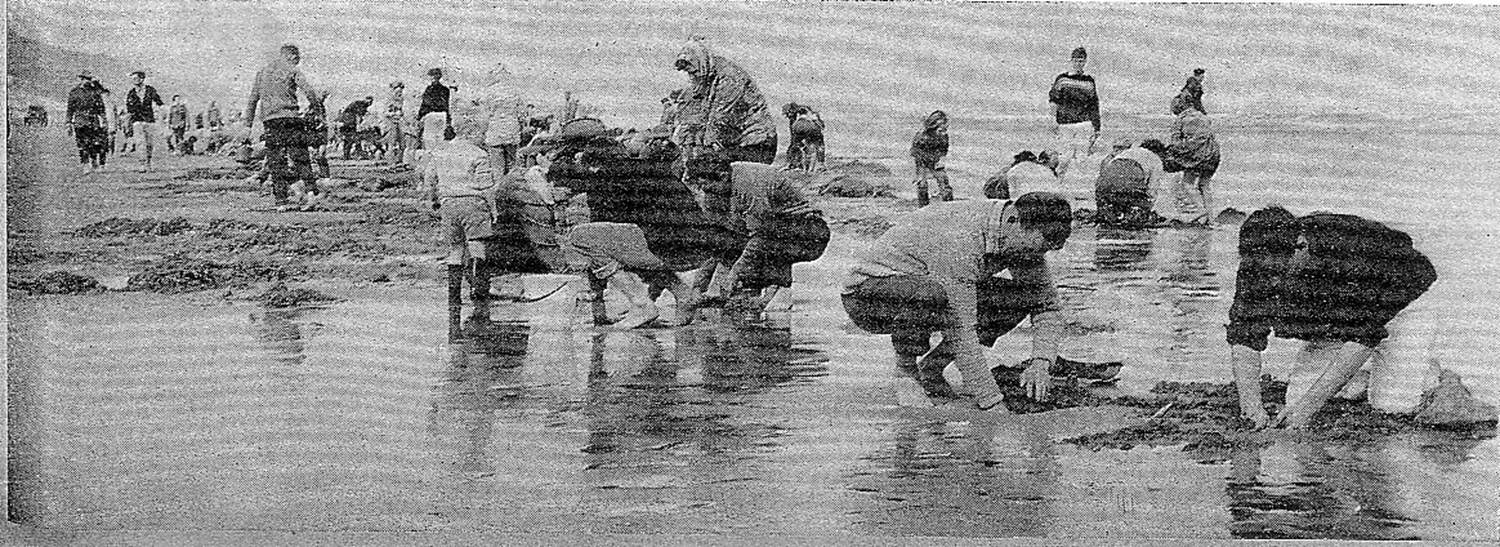 Abundant Toheroa harvest a community event, now a fading memoryBenefits of marine reserves can be wide ranging including social, educational, cultural and economic. All these benefits can be considered as evidence that a marine reserve should be created in a given area. The Marine Reserve Act and High Court decisions that objections to creating a marine reserves based on perceived loss of fishing opportunity can be balanced against benefits and the public good created by the marine reserve. For this reason collecting information on social and economic benefits can be useful supportive information to assemble.
Abundant Toheroa harvest a community event, now a fading memoryBenefits of marine reserves can be wide ranging including social, educational, cultural and economic. All these benefits can be considered as evidence that a marine reserve should be created in a given area. The Marine Reserve Act and High Court decisions that objections to creating a marine reserves based on perceived loss of fishing opportunity can be balanced against benefits and the public good created by the marine reserve. For this reason collecting information on social and economic benefits can be useful supportive information to assemble.
There are some excellent publications that you can study to gain an understanding of what communities and New Zealanders think about creating marine reserves. This could help you to design your own public survey in your area.
Economic studies are not common for marine reserves, but impacts at the Leigh Marine Reserve and Poor Knights have been documented and are substantial.
Visitor Use Surveys
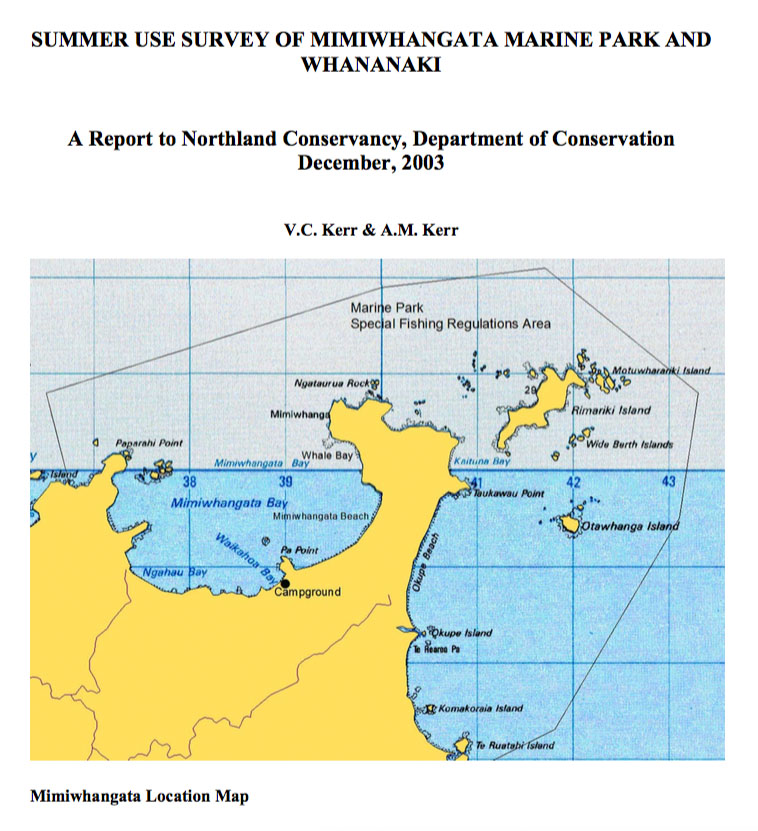 At Mimiwhangata it was found that a large proportion of visitors are engaged in non-extractive nature based activitiesVisitor use surveys have been carried out for a number of marine reserve proposals and can be very important for two reasons, 1) it is important to know and document who is affected by a proposed marine reserve, 2) in most cases the results are surprising and you will find that non-extractive users such as hikers sightseers etc, (people who are not taking fish or marine life), actually outnumber the fishers.
At Mimiwhangata it was found that a large proportion of visitors are engaged in non-extractive nature based activitiesVisitor use surveys have been carried out for a number of marine reserve proposals and can be very important for two reasons, 1) it is important to know and document who is affected by a proposed marine reserve, 2) in most cases the results are surprising and you will find that non-extractive users such as hikers sightseers etc, (people who are not taking fish or marine life), actually outnumber the fishers.
An important aspect of the legal criteria for the establishment of a marine reserve is the determination of the implications of reserve establishment for current users. This will necessarily involve a discussion of potential changes, including benefits, that would result from marine reserve establishment. Obviously, new uses like increased ecotourism and educational activities would be weighed against any disruption that would occur to existing users of the area in question.
In order to satisfy this requirement it is wise to complete some sort of survey of existing use. There are many ways to approach this, but in the end the more detailed and scientifically robust the survey effort is the more valuable it will be.
Here are some tips for this work:
➢ Research all past efforts to describe use of your area; check local DoC and Council libraries and with your contact people
➢ Utilize existing fishing information as much as possible
➢ Consider extending your information gathering to adjacent 'control' areas near your area of interest for a marine reserve. This is important to allow you to discuss the opportunity for existing users to continue their activity in adjacent areas if a marine reserve is established
➢ Get advice on the methods that you intend to use – it is important that best possible methods are used to avoid problems of biases, samples too small, wrong time of year etc.
➢ Enlist the support and help of people on site, or on the water
➢ Consider 'piggy backing' the activity on to some pre-existing information gathering activity or public event
➢ Pilot or trial any idea you have first, including a dummy run of what your final results are intended to look like. Most problems with surveys only become apparent during the final analysis
➢ Make use of personal interviews of key people and resource users in the area and document these carefully
➢ Remember that survey activity on your part can also be an education, advocacy and community involvement exercise producing more than just information.
Note: See Appendix 2 of DoC, 2002, Building Community Support for Marine Protection. This summarises the socioeconomic impact assessments for Te Whanganui-a-Hei, Cathedral Cove and Cape Rodney – Okakari Point (Leigh) established marine reserves, and indicates the topics you should be canvassing in your own area.
Visitor Survey examples
